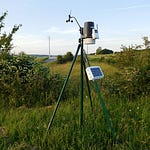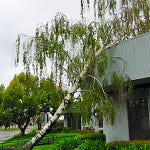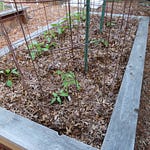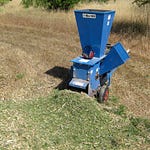Today’s Podcast: Debbie Flower and I tackle the problem of a slow draining lawn. There are lots of strategies for improving a soggy lawn!
Where does the water go?”
That’s a question I frequently ask myself while bicycling throughout the region, staring at rain-soaked suburban yards. This is also a question homeowners should ask themselves before, during, and after the rainy season.
One of the best pieces of advice I can offer any new homeowner: before you spend any time and money on landscaping projects or a garden, live with the existing property for a year. This allows you to take monthly pictures of the area where you want a future garden, perennials, shrubs and trees.
When we moved to our new home nine years ago, that’s what we did before we embarked on a totally redesigned landscape. Taking a series of pictures on a regular basis on sunny days, especially at different times of the day (9am, 1pm, 5pm), will remind you how much shade your future plants will be dealing with, and you can plant accordingly.
A plant labeled for “full sun” will need at least six hours (preferably eight hours) of direct sun a day. “Part Sun/Part Shade” plants, 4-6 hours of sun per day. “Shade” should be reserved for those plants that get little direct sun (less than four hours) and preferably dappled sun, such as protection from an overhanging deciduous tree.
However, the more important reason to live with that new yard for a year before embarking on outdoor landscaping projects: figure out where water goes, both after regular irrigation and after rainstorms. In our case, we discovered that few of the yard sprinklers worked fully or accurately, and that a heavy downpour of rain ends up in the garage. And the basement would flood.
As a result, the price of our landscape rehab zoomed upward, to include a complete drip irrigation system for both the front yard and backyard, as well as an underground hard pipe drain system to move roof gutter water away from the house and garage to another part of the yard.
Home and Garden Pests That Sing in the Rain
The other problem with wet weather: some home and garden pests love it when it’s wet; and others will seek refuge in drier quarters, such as in your home.
The authors of the University of California Ag and Natural Resources publication, “Pests in the Urban Landscape,” offer some “Wet Weather Do’s and Don’ts” to ward off problems:
• Check for snails and slugs. They like it moist and will sing in the rain. Unfortunately, their singing sounds a lot like, “chomp, chomp, chomp.” These garden leaf and flower munchers don’t like it too wet. They may be easily found headed for dry land – sidewalks and driveways – during a deluge. Find them under loose boards, as well. That’s the time for hand-picking or stomping them. Chemical controls for these mollusk family members are ineffective in the rain.
• Remove weeds and unwanted plants. When the ground is wet, pulling them out goes much more quickly. Among the winter weeds spreading here right now are oxalis, nutsedge and groundsel. You may have other cool season weedy invaders in your yard.
• Dump standing water. This wet winter is already favoring a big mosquito season ahead. Deprive breeding mosquitoes of water-nesting sites such as flowerpot saucers, wheelbarrows, buckets, clogged storm drains, and roof gutters.
• Check for ants, cockroaches, and earwigs. These pests may invite themselves into your home when flooding or heavy rains make the outdoors unappealing to them. Seal any cracks or openings in your home. Outdoors, check the perimeter of your home as well as around doors and windows for insect entryways. Weather stripping, door sweeps, and traps placed beneath eave-protected walkways can help keep them outside. Indoors, keep food tightly sealed and the counters clean, especially near electrical outlets that might provide an entryway.
• Remove yard mushrooms. Mild temperatures and wet soil are a combination that mushrooms and other fruiting bodies of fungi love. The good news is they are not harmful to your lawn and garden. The bad news? They can be poisonous to children and pets, when consumed. Rake them up.
• Don’t apply outdoor fertilizer or pesticides now. Both are easily susceptible to being washed off the soil or plants and into our waterways. Wait for several days of dry weather before applying any sprays, dusts, liquids, or granules.
• Avoid pruning plants unless it is to remove broken or damaged branches. Rainfall and open wounds in the winter on plants is a recipe for spreading diseases. Apricots, cherries, and olives should never be pruned during cool, wet, conditions, advises UCANR.
• A common site on sidewalks after a rainstorm are worms, struggling to get out of the wet soil and onto dry land. If you have easy draining soil, you may see their mounds in lawns and gardens as they come up temporarily for air. Those mounds are a great fertilizer: worm castings. Just knock them down with your foot or a rake to feed the soil.
• Tread lightly through the garden during or just after a rainstorm. Avoid walking, driving, or moving heavy equipment across wet soil. This compacts the soil, removing necessary air pockets, which are vital for healthy trees, shrubs, and other plants.
• One other tip: if you have slow draining areas of your yard after a deluge, mark them. Stick a small stake or object on top of those areas to let you know that the area needs drainage help after the rainy season. Avoid planting in consistently wet areas. Consider putting in a drain system to move that water to another part of the yard to make it more habitable for plant life. Or, consider placing a large container or raised bed in that area for a successful garden.
PODCAST TRANSCRIPT - LAWN DRAINAGE TIPS
Farmer Fred
We like to answer your garden questions. Debbie Flower is here, America’s favorite retired college horticultural professor. Evan writes us from San Jose, which is south of San Francisco, a very mild climate that used to be an area of a lot of fruit orchards, way back when. Now it’s the tech hub with million dollar, two bedroom homes. All right. Go figure. Anyway, Evan writes, “I live in San Jose and in my backyard, I have a very small patch of grass that is around 200 square feet. I want to keep this patch because my daughter practices her gymnastics on it. But in the rainy season, it becomes a swampy bog, so I have to fight the moisture for a few months. During that period, I tend to aerate it with my fork quite a bit. Usually I spend 15 minutes aerating it each week to help it dry out and de-compact it. I usually only disturb the top four to six inches of the soil. But I’m starting to worry that I’m doing too much. Is it possible to aerate the lawn too much? Can you recommend any non-destructive ways to fight moisture and compaction? On a small lawn?” My first comment to Evan is, if you’re using a fork, you’re not aerating the soil. You are compacting it.
Debbie Flower
Yeah, you’re creating holes, but pushing the soil to the side which is causing compaction on either side of that. And maybe creating more of a drainage issue. I assume he’s having success, or he wouldn’t be doing this over and over and over again.
Farmer Fred
Well, he says it’s a fork, but doesn’t give details about the fork.
Debbie Flower
I’m picturing a garden fork. Yeah. And that’s just just tines. Yes, aeration should be done with tubes, hollow tubes that take out a chunk of the soil and whatever roots are in it. And they look if you’ve ever seen goose poop, what they take out of the hole when they’re aerated with a hollow tine aerator looks like goose poop.
Farmer Fred
Yeah, if you want to aerate, I still like the idea of renting a power aerator because as it picks out those cores of soil, the device also eject them on top of the soil. And you want to be able to do that. I think with a hand aerator, it’s two motions. You punch down, and then when you bring it back up, you have to eject the cores of soil.
Debbie Flower
It’s a lot of work.
Farmer Fred
It’s a lot of work and Evan, you’re working too hard.
Debbie Flower
Right. You use a hollow tine aerator of some sort to aerate the soil. Then you want to collect those goose poops, that are about the size of my pinky finger, perhaps three inches long and maybe a quarter to a half an inch across. Then smash them up so that they’re just loose soil and then rake them in over the top. Or rake in some sand. Something that would hold those holes open and allow air and water to move through them.
Farmer Fred
And I guess you could do that with a spreader of some sort. I know that in a lot of situations where you’re rehabbing a lawn, and you’re dethatching and aerating, that’s the other thing you might consider, too, is dethatching your lawn. But people who have a rhizomatous... is that a word? Thank you. Rhizomatous or stoloniferous lawn... that can tend to build up a lot of dead material below the surface that you don’t ever see, until you bring in a dethatcher. And all of a sudden you’ve got two cubic yards of dead lawn material to dispose of. And that can help drainage quite a bit as well.
Debbie Flower
So those typical grasses that would have that problem are bluegrass, Bermuda grass, and creeping red fescue.
Farmer Fred
Yes, that’s why it’s usually a creeping grass. Exactly.
Debbie Flower
Yeah, they fill in really well. If you’re a golfer. You would love that because it fills in your divots you make but it’s a harder grass to maintain because of those stems that crawl across the surface and under the surface of the soil.
Farmer Fred
Fortunately Evan, it’s only 200 square feet. And maybe you can get through what you’re calling the aeration process in 15 minutes a week. But I have a funny feeling you’re just compacting the soil.
Debbie Flower
Right. My first question after reading his question is what’s causing the flooding? Is the lawn in the lowest part of that landscape so that water is flowing to it? Is it clay soil, so it just takes a longer time to drain? We’re getting more storms that are dropping a lot of rain in a short period of time. And clay soil absorbs water very slowly. So is that the problem? Or is it a perched water table, meaning there are soils with two different types of textures on top of each other, which often happens in new housing developments. That’s because they scrape the land clear, then they build the houses and drive heavy equipment all over the property around the house. And then they bring in, without touching that now compacted soil around the house, they bring in some sort of topsoil mix and throw sod on it. And so you’ve got the sod, which is always grown in a very loose soil, and then whatever they brought in, which is typically a very loose soil, and then this very compacted soil beneath it. That would slow down water penetration. So if you can figure out what’s causing the problem, it’s easier to fix it.
Farmer Fred
One way to do that would be to take out a fairly sizable core of your existing lawn using a flat headed shovel. And make a little square, maybe eight inches by eight inches by eight inches by eight inches, and go down about eight inches, and then bring up that whole block and see what it looks like. Look at the layers. I wouldn’t be surprised that there is this layer of dead stuff right under the green stuff. And then you’re going to have loose soil, and then you’re going to have the compacted soil, and you want to see how deep do the roots go? And if the roots are just going around the top because, who wants to go into compacted soil? Okay, well, that might be the issue right there, right.
Debbie Flower
And the damp season is the time to do it. Because the soil would be easier to dig in. It’ll stick together better when you pull it out. So if that’s the case, then you’ve got to create some penetration, some breaks some open spaces between the top of the soil, the stems we’re talking about that you would aerate and dethatch to get rid of, and the soil below. So vertical core aeration might fix that as your fork tines only go about four inches deep. So does vertical core aeration, only go four inches deep. If that doesn’t do the job. If your soil layers are deeper than that, the compacted one that you need to break open is deeper than that, then you’re gonna have to dig holes in places and allow the water to drain there.
Farmer Fred
Yes, or hardscaping? Yes. Well, there’s that.
Debbie Flower
One other process that may work but it will take years. Golf apparently was invented in Scotland. I am not a golfer. Maybe your wife knows this. But according to my turf professor at UC Davis, Golf was invented in Scotland and the best golf courses were right on the coast. I guess they’re called the moors. I’m not positive about that. But the reason they were so good is that the soil was quite well drained. And sand would blow up from the beaches below and basically the sand top dressed the lawns every year, with just a little bit of sand, and that is healthy for a lawn to top dress. There are reasons to do it. Usually the reasons are to either apply nutrition in the form of a compost or composted manure, and to fill in holes. If you’ve got a lumpy lawn, and you can fill in holes, you can do it every year, you can do it probably twice a year, but you’re only applying a quarter to a half an inch of top dress. And the top dress soil needs to be very close to the soil the grass is already growing in. The texture of the two need to match. So you may have to buy topsoil. At a topsoil place, you can mix it up to 1/3 to one half with sand, horticultural sand, and just spread a layer of quarter to half inch over the whole lawn. The grass will grow up into it, it will root into it. And so over time, you’re going to raise your lawn, the organic component of what you applied is going to break down, but the sand is going to stay there. So you’re gonna raise your lawn maybe a half an inch a year, and you might raise it right up out of that wet spot.
Farmer Fred
I have, I believe in the past, written on the Farmer Fred Rant blog page about rehabbing a lawn that included specific instructions on dethatching and aeration, as well as overseeding. And then covering with that top dress material. You can get some good ideas at the soil place on the machinery that makes it a lot easier, like a bigger roller. Actually, you probably want two rollers. If you’re overseeding, you got one that’s filled with water to get the seeds down into the soil, and then a rolling cage with small holes that you fill with compost and roll it across the lawn. And it does a very good job. And I have seen those at rental places. Hey, a good nursery will lend it to you know, for the day. There you go. Yeah, that’s the way to do it. But Evan, yeah, if you’re doing it every week, for 15 minutes, you’re doing it way too much. You throw out a phrase, Debbie of doing it, maybe twice a year. All right. But again, you’re removing cores. Unfortunately, but I’m glad to say we’re getting away from this scenario, of when people have a garden problem. They go into a nursery and say, “What can I buy to fix this?” We were at a nursery yesterday. Yes. And we saw a product that I would might think that a an employee who didn’t know better or was trying to make a sale might say, “Yeah, we got something we can sell you. It’s a natural soil food for lawns and hard soils it it loosens compacted soil that improves root penetration, mass and grass growth and also helps to stimulate microbial life and it’s only 30 bucks.” And, okay, what’s in it? Well, that’s a darn fine question. And we were looking at that bag yesterday. I don’t think we ever decided what was in it. Or were the ingredients even listed in the back. I should check my notes on that.
Debbie Flower
I think it was sulfur and calcium. Yeah. And iron. Yeah, that’s what it was. It was micronutrients. Yeah, grass needs those, but it’s not going to open your soil. The only kind of soil that this product will have any effect on his sodic soil. That is what it’s called. And it’s soil with salt in it. There are places where salt and I’m talking like table salt, but there are other salts as well. But tablesalt has sodium in it, where sodium naturally collects in the soil and binds it, making it tight. Calcium can be applied to such soils. And it binds where the sodium is, and releases the sodium and opens up the soil. And typically you apply calcium with sulfur because calcium will greatly change the pH or the alkalinity and acidity of your soil. Sulfur will prevent that from happening with this application. So there’s only one very limited situation where this product is going to do anything, other than provide nutrients.
Farmer Fred
You’d be better off spending your money on a fine compost and rolling that over the lawn. Yes.
Debbie Flower
And I was saying that this process, the top dressing, can be done twice a year. I wouldn’t dethatch and aerate more than once a year. Okay. You want to do the top dressing when the grass is actively growing. I like to topdress in spring when the forsythia shrubs bloom. That’s typically when the soil is warm enough for the spring weed seeds to germinate. And I like to top dress to cover up those baby seedlings so they can’t find the sun and they don’t grow.
Debbie Flower
I love horticultural phenology. And that’s what that is. You do garden chores based on what’s in bloom or what’s happening in the garden. And the forsythia bloom usually happens in late winter.
Debbie Flower
Or early spring when the soil is just getting warm enough for things to germinate. Or you find you’re mowing the lawn more often.
Farmer Fred
Yes, there’s that too. Again, most lawns, and we don’t know what type of lawn Evan has. So it could be a cool season lawn. It could be a warm season lawn. Yes.
Debbie Flower
And in San Jose, I would guess would be a cool season lawn.
Farmer Fred
yeah, but you never know. So, Evan, stay off your lawn.
Debbie Flower
Yeah, don’t walk on it when it’s really wet. That compacts the soil in and of itself.
Farmer Fred
Exactly. Now, it should be moist when you do this work, but not so soggy, not too soggy. That would actually compact the soil. Because when you compact the soil, you’re removing air, right? Air is a necessity for root growth.
Debbie Flower
Yes, it is. Good luck.
Farmer Fred
There’s a lot I would do in this situation, I think. Perhaps start over. Start over, get some professional equipment. I would first of all, I’d dig out that chunk that eight by eight inch chunk.
Debbie Flower
You got to know what’s going on down there. Yeah, identify the pest, if you will. If you do that send us a picture.
Farmer Fred
Yeah, it could be the thatch layer that needs to get removed, if you see a layer of dead stuff below the green stuff before it hits soil. If, on the other hand, when you dig that out and it’s just dripping water, well, then you’ve got a watering issue. That could be the flow from your neighbor’s sprinklers or your own sprinklers. And it just may be as you said, Debbie, just a low lying area. But if it’s supporting a lawn, lawns are amazingly resilient.
Debbie Flower
They are. That’s why people like them. You only have to know one set of instructions to care for a lawn. Yes. Yeah, I suspect there’s layers of soil in there that are impeding water flow. And if it smells, you really got a problem. Yes, it smells like low tide. Or dead fish.
Farmer Fred
Yeah, that means your soil is getting way too much water. And so think about where the water is coming from and how much you’re watering. It sounds like maybe you can turn off the sprinklers, if that’s the issue.
Debbie Flower
Yeah. And maybe your daughter needs a really nice mat or trampoline..
Farmer Fred
Yeah, we don’t want to discourage your daughter, Evan, from practicing her gymnastics. But yeah, a mat. That makes sense, a 200 square foot mat. right? Yeah. And you’d save yourself a lot of work, it would be a worthwhile investment, right?
Debbie Flower
And then, when she’s done, or moved on, you can raise that soil level and have a lawn or whatever you want to grow in that location.
Farmer Fred
Or, you can leave the mat there and sleep out there at night because your wife kicked you out. So there’s always that. All right, so good luck with improving your lawn drainage there, Evan. Thanks for writing in to the Garden Basics podcast, and thank you, Debbie.
Debbie Flower
You’re welcome, Fred.
Thanks for Subscribing and Spreading the Word About the Beyond the Basics: The Garden Basics with Farmer Fred newsletter, I appreciate your support.
Fred Hoffman is also a University of California Cooperative Extension Master Gardener in Sacramento County. And he likes his bikes.















